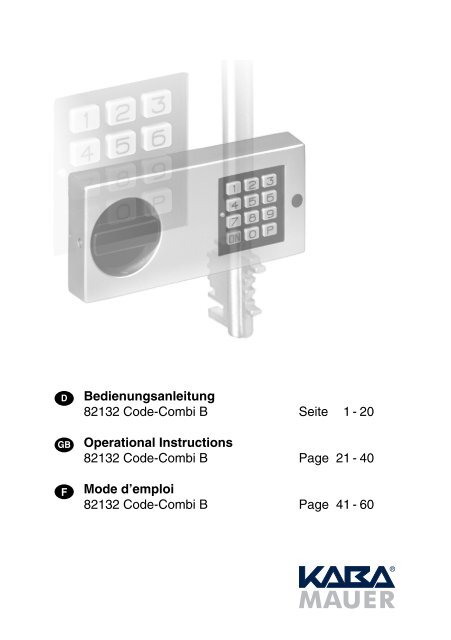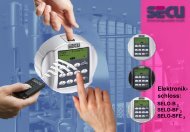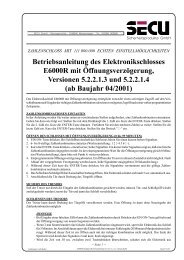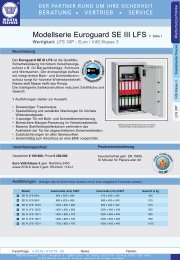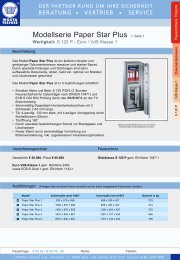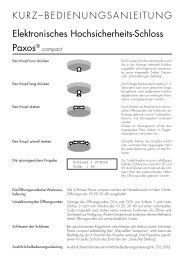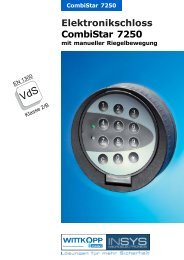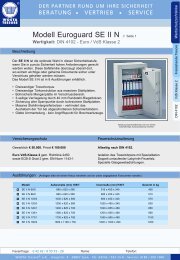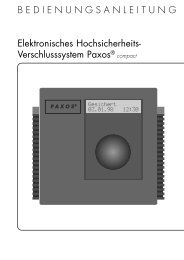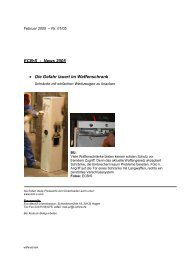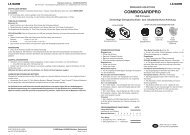Bedienungsanleitung 82132 Code-Combi B Seite 1 ... - hdg - tresore
Bedienungsanleitung 82132 Code-Combi B Seite 1 ... - hdg - tresore
Bedienungsanleitung 82132 Code-Combi B Seite 1 ... - hdg - tresore
- No tags were found...
You also want an ePaper? Increase the reach of your titles
YUMPU automatically turns print PDFs into web optimized ePapers that Google loves.
DGBF<strong>Bedienungsanleitung</strong><strong>82132</strong> <strong>Code</strong>-<strong>Combi</strong> B <strong>Seite</strong> 1 - 20Operational Instructions<strong>82132</strong> <strong>Code</strong>-<strong>Combi</strong> B Page 21 - 40Mode d’emploi<strong>82132</strong> <strong>Code</strong>-<strong>Combi</strong> B Page 41 - 60
InhaltsverzeichnisD1 Bedienhinweise........................................................................................................... 22 Signale und ihre Bedeutung....................................................................................... 33 Bedienmodi.................................................................................................................. 44 Schlossfunktionen...................................................................................................... 54.1 Funktion Paralleler Modus......................................................................................... 54.1.1 Öffnen mit Erst- oder Zweitcode4.1.2 Öffnen nach 3 oder mehr fehlerhaften <strong>Code</strong>eingaben Sperrzeit4.1.3 Ändern des Erstcodes durch Erstcodeinhaber4.1.4 Zuschalten/Ändern des Zweitcodes durch Erstcodeinhaber4.1.5 Ändern des Zweitcodes durch Zweitcodeinhaber4.1.6 Löschen des Zweitcodes durch Erstcodeinhaber4.1.7 Schließen4.2 Funktion Delegierter Doppelcode Modus................................................................. 74.2.1 Zuschalten/Ändern eines Doppelcodes durch Erstcodeinhaber4.2.2 Öffnen4.2.2.1 Öffnen mit Erstcode durch Erstcodeinhaber4.2.2.2 Öffnen mit Doppelcode durch Doppelcodeinhaber4.2.3 Öffnen nach 3 oder mehr fehlerhaften <strong>Code</strong>eingaben Sperrzeit4.2.4 Ändern des Erstcodes durch Erstcodeinhaber4.2.5 Löschen des Doppelcodes durch Erstcodeinhaber4.2.6 Schließen4.3 Funktion Einfacher Doppelcode Modus.................................................................... 104.3.1 Aktivierung des Einfachen Doppelcode Modus durch Erstcodeinhaber4.3.2 Öffnen mit Doppelcode durch Doppelcodeinhaber4.3.3 Öffnen nach 3 oder mehr fehlerhaften <strong>Code</strong>eingaben Sperrzeit4.3.4 Ändern des Doppelcodes durch Doppelcodeinhaber4.3.5 Löschen des Einfachen Doppelcode Modus4.3.6 Schließen4.4 Funktionen Öffnungsverzögerung (ÖV) und Öffnungsbereitschaftszeit (ÖZ)....... 124.4.1 Zuschalten/Ändern der ÖV/ÖZ durch Erstcodeinhaber4.4.2 Öffnen bei programmierter ÖV/ÖZ4.4.3 Löschen der programmierten ÖV/ÖZ durch Erstcodeinhaber4.5 Stromversorgung........................................................................................................ 134.5.1 Batteriewechsel bei separatem Batteriekasten4.5.2 Batteriewechsel bei integriertem Batteriekasten4.6 Revisionsöffnung mit Schlüssel bei Kunststoffbedieneinheit................................ 154.6.1 Öffnen4.6.2 Schließen4.7 Revisionsöffnung mit Schlüssel bei Aluminiumbedieneinheit............................... 174.7.1 Öffnen4.7.2 Schließen4.7.3 Löschen der Signale4.8 Kurzanleitung Revisionsöffnung............................................................................... 19Kaba Mauer GmbH <strong>82132</strong> <strong>Code</strong>-<strong>Combi</strong> B <strong>Seite</strong>
D1 BedienhinweiseWichtige Hinweise• Vor Inbetriebnahme des Schlosses bitte die <strong>Bedienungsanleitung</strong> sorgfältig lesen.• Programmiervorgänge nur bei geöffnetem Schloss und geöffnetem Wertbehältnis durchführen.• Jede korrekte und vom Schloss anerkannte Tastenbetätigung wird mit einem akustischenSignal bestätigt. Diese Bestätigungssignale werden in den folgenden Beschreibungen nichtberücksichtigt.• Für jede einzelne Tasteneingabe haben Sie max. 20 Sekunden Zeit. Wenn innerhalb dieser20 Sekunden keine Taste bedient wurde, schaltet sich die Elektronik automatisch ab. Nichtbeendete Bedienungen müssen danach neu gestartet werden.• <strong>Code</strong>eingaben können durch Drücken der Taste P abgebrochen werden.• Das Schloss ist bei Auslieferung auf den Werkscode 1 2 3 4 5 6 eingestellt. Ändern Sie ausSicherheitsgründen diesen Werkscode sofort auf Ihren persönlichen <strong>Code</strong>. Verwenden Siefür Ihren <strong>Code</strong> keine persönlichen oder ähnlich bekannten Daten (z.B. Geburtstage).• Das Schloss verfügt über eine Manipulationsüberwachung, die auch bei Servicediensten ander Bedieneinheit aktiviert wird. Die Manipulationsüberwachung wird ebenfalls beim Öffnendes Batteriefaches, wenn es in die Bedieneinheit integriert ist, aktiviert. Dieses Manipulationssignalmuss später gelöscht werden.• Sofern die Batterie nicht von außen zugänglich ist, muss bei entladener oder defekter Batteriedas Schloss über den Revisionsschlüssel geöffnet werden.• Der Revisionsschlüssel ist an einem sicheren Ort, jedoch nicht im Wertbehältnis aufzubewahren.Allgemeine Hinweise• Das Schloss ist zur Nutzung im Temperaturbereich von +10 °C bis +50 °C und einer Luftfeuchtigkeitvon 30% bis 80 % nicht kondensierend ausgelegt.• Die Reinigung darf nur mit einem feuchten Tuch erfolgen (keine aggressiven Reinigungsmittelverwenden).• Das Schloss darf nicht gefettet werden.• Öffnen Sie niemals das Schlossgehäuse. Falls Demontagen am Beschlag erforderlich sind,diese nur entsprechend den Vorgaben in dieser <strong>Bedienungsanleitung</strong> ausführen. Ansonstengefährden Sie die Funktionen des Schlosses und verlieren den Gewährleistungsanspruch.<strong>Seite</strong> <strong>82132</strong> <strong>Code</strong>-<strong>Combi</strong> B Kaba Mauer GmbH
2 Signale und ihre BedeutungDKunststoffbedieneinheit:Balkengriffgrüne LEDrote LEDBalkengriffAluminiumbedieneinheit:kombiniert grün/rote LEDAbb. 1: BedieneinheitenSymbol Signal Bedeutung1 x Grüne LED blinkt 1 malGrüne LED leuchtet konstant3 x Rote LED blinkt 3 mal Falscheingabe10 x1, 2, 4, 8 oder16 Minuten3 x//Rote LED blinkt 10 malnach Drücken der ON-TasteRote LED blinkt im Sekundentakt1, 2, 4, 8 oder 16 Minuten nachmindestens 3 maliger falscher<strong>Code</strong>eingabeRote LED blinkt alle 5 SekundenRote und grüne LED blinken abwechselnd3 malRote und grüne LED blinkenabwechselnd begleitet von einemakustischen SignalGrüne LED blinkt alle 5 Sekundenbegleitet von einem akustischenSignalGültiger 6-stelliger <strong>Code</strong> wurdeeingegebenSchloss ist programmierbereitUnterspannung der BatterieSchloss befindet sich in derSperrzeitSchloss befindet sich in derÖffnungsverzögerungSchloss wurde zuletzt mit einemanderen <strong>Code</strong> geöffnetKunststoffbedieneinheit:Blende an der Bedieneinheit wurdefür Schlüsselöffnung abgenommenAluminiumbedieneinheit:Batteriefachdeckel wurde für Batteriewechselgeöffnet oder Manipulationsversuch(Demontage derBedieneinheit) liegt vorSchloss befindet sich in der Öffnungsbereitschaftszeit1 x Akustisches Signal ertönt 1 mal Z.B. Ende Öffnungsbereitschaftszeit2 x Akustisches Signal ertönt 2 mal3 x Akustisches Signal ertönt 3 malZ.B. bei Programmierung wurdeneuer 6-stelliger <strong>Code</strong> eingegebenZ.B. bei Programmierung wurde ungültiger6-stelliger <strong>Code</strong> eingegebenKaba Mauer GmbH <strong>82132</strong> <strong>Code</strong>-<strong>Combi</strong> B <strong>Seite</strong>
D3 BedienmodiDas Schloss kann mit einem <strong>Code</strong> (Erstcode), mit zwei <strong>Code</strong>s (Erst- oder Zweitcode) oder miteinem Doppelcode (1. und 2. Teilcode) geöffnet werden. Nur der Inhaber des übergeordnetenErstcodes kann den Zweitcode und den Doppelcode freigeben.Erstcode: 6-stellige GeheimzahlZweitcode: Zusätzliche 6-stellige Geheimzahl für weiteren Benutzer des WertbehältnissesDoppelcode: Aus zwei 6-stelligen Teilcodes bestehende 12-stellige Geheimzahl für zweiBenutzer des Wertbehältnisses. Beide Benutzer müssen zur Öffnung desSchlosses ihren 6-stelligen Teilcode eingeben (Vieraugenprinzip).Bei der Bedienung des Schlosses unterscheidet man 3 Bedienmodi. Die Öffnungsberechtigungder unterschiedlichen Modi wird nachfolgend dargestellt.Werkseitig eingestellt ist der Parallele Modus. Als Erstcode ist der Werkscode 1 2 3 4 5 6programmiert. Ein Zweitcode ist werkseitig nicht programmiert.I. Paralleler ModusErstcodeZweitcodeII.Delegierter Doppelcode ModusErstcodeDoppelcodeIII.Einfacher Doppelcode ModusDoppelcode<strong>Seite</strong> <strong>82132</strong> <strong>Code</strong>-<strong>Combi</strong> B Kaba Mauer GmbH
4 SchlossfunktionenDProgrammiervorgänge nur bei geöffnetem Schloss und Wertbehältnis durchführen.4.1 Funktion Paralleler ModusErstcodeZweitcode4.1.1 Öffnen mit Erst- oder Zweitcode1) ON drücken2) Gültigen 6-stelligen Erst- oder Zweitcode eingeben 1 x3)Balkengriff innerhalb von 4 Sekunden im Uhrzeigersinn bis zumAnschlag drehenWurde das Schloss zuletzt mit einem anderen <strong>Code</strong> geöffnet, erfolgt die Signalmeldung3 x .4.1.2 Öffnen nach 3 oder mehr fehlerhaften <strong>Code</strong>eingaben SperrzeitNach 3 fehlerhaften Eingaben schaltet das Schloss in eine 1-minütige Sperrzeit. Bei jederweiteren fehlerhaften <strong>Code</strong>eingabe erfolgt eine Verlängerung der Sperrzeit auf 2, 4, 8 undmax. 16 Minuten. Während der Sperrzeit blinkt die rote LED im Sekundentakt und es ist keineweitere <strong>Code</strong>eingabe möglich. Die Sperrzeit kann mit dem Revisionsschlüssel übergangen,jedoch nicht gelöscht werden (siehe 4.6 bzw. 4.7).1) Nach Ablauf der Sperrzeit zu einem beliebigen Zeitpunkt ON drücken2) Gültigen 6-stelligen <strong>Code</strong> eingeben 1 x3)Meldung: ungültiger 6-stelliger <strong>Code</strong> wurde bei einem früheren ÖffnungsversucheingegebenBalkengriff innerhalb von 4 Sekunden im Uhrzeigersinn bis zumAnschlag drehen3 x4.1.3 Ändern des Erstcodes durch Erstcodeinhaber1) Schloss mit gültigem 6-stelligen Erstcode öffnen (siehe 4.1.1)2) ON drücken3) P drücken4) Gültigen 6-stelligen Erstcode eingeben5) Neuen 6-stelligen Erstcode eingeben / 2 x6) Neuen 6-stelligen Erstcode nochmals eingeben 1 x7)Neu programmierten Erstcode durch Schließen und nochmaligesÖffnen testenKaba Mauer GmbH <strong>82132</strong> <strong>Code</strong>-<strong>Combi</strong> B <strong>Seite</strong>
DWurde der neue Erstcode in 6) nicht korrekt bestätigt, erfolgt die Signalmeldung 3 x .Den Vorgang wiederholen.4.1.4 Zuschalten/Ändern des Zweitcodes durch Erstcodeinhaber1) Schloss mit gültigem 6-stelligen Erstcode öffnen (siehe 4.1.1)2) ON drücken3) P drücken4) Gültigen 6-stelligen Erstcode eingeben5) P drücken6) 3 drücken7) Neuen 6-stelligen Zweitcode eingeben / 2 x8) Neuen 6-stelligen Zweitcode nochmals eingeben 1 x9)Neu programmierten Zweitcode durch Schließen und nochmaligesÖffnen testenWurde der neue Zweitcode in 8) nicht korrekt bestätigt, erfolgt die Signalmeldung 3 x .Den Vorgang wiederholen.4.1.5 Ändern des Zweitcodes durch Zweitcodeinhaber1) Schloss mit gültigem 6-stelligen Zweitcode öffnen (siehe 4.1.1)2) ON drücken3) P drücken4) Gültigen 6-stelligen Zweitcode eingeben5) Neuen 6-stelligen Zweitcode eingeben / 2 x6) Neuen 6-stelligen Zweitcode nochmals eingeben 1 x7)Neu programmierten Zweitcode durch Schließen und nochmaligesÖffnen testenWurde der neue Zweitcode in 6) nicht korrekt bestätigt, erfolgt die Signalmeldung 3 x .Den Vorgang wiederholen.4.1.6 Löschen des Zweitcodes durch Erstcodeinhaber1) Schloss mit gültigem 6-stelligen Erstcode öffnen (siehe 4.1.1)2) ON drücken3) P drücken4) Gültigen 6-stelligen Erstcode eingeben5) P drücken6) 0 drücken 1 x<strong>Seite</strong> <strong>82132</strong> <strong>Code</strong>-<strong>Combi</strong> B Kaba Mauer GmbH
Durch Drücken der Tastenkombination P und 0 werden alle programmierten Funktionen(Zweitcode, Doppelcode, Öffnungsverzögerung, Öffnungsbereitschaftszeit) gelöscht.D4.1.7 SchließenIn Verbindung mit einem Riegelwerk muss nach dem Schließen der Tür das Riegelwerk verriegeltund danach das Schloss geschlossen werden.1) Balkengriff gegen den Uhrzeigersinn bis zum Anschlag drehen4.2 Funktion Delegierter Doppelcode ModusErstcodeDoppelcode4.2.1 Zuschalten/Ändern eines Doppelcodes durch Erstcodeinhaber1) Schloss mit gültigem 6-stelligen Erstcode öffnen (siehe 4.1.1)2) ON drücken3) P drücken4) Gültigen 6-stelligen Erstcode eingeben5) P drücken6) 5 drücken7) Neuen 6-stelligen 1. Teilcode eingeben / 2 x8) Neuen 6-stelligen 1. Teilcode nochmals eingeben 1 x9) Neuen 6-stelligen 2. Teilcode eingeben / 2 x10) Neuen 6-stelligen 2. Teilcode nochmals eingeben 1 x11)Neu programmierten Doppelcode durch Schließen und nochmaligesÖffnen testenWurde der 1. oder 2. Teilcode nicht korrekt bestätigt, erfolgt die Signalmeldung 3 x .Den Vorgang wiederholen.Die Reihenfolge der Teilcodes und deren nochmalige Bestätigung muss eingehalten werden.Kaba Mauer GmbH <strong>82132</strong> <strong>Code</strong>-<strong>Combi</strong> B <strong>Seite</strong>
4.2.4 Ändern des Erstcodes durch ErstcodeinhaberD1) Schloss mit gültigem 6-stelligen Erstcode öffnen (siehe 4.2.2.1)2) ON drücken3) P drücken4) Gültigen 6-stelligen Erstcode eingeben5) Neuen 6-stelligen Erstcode eingeben / 2 x6) Neuen 6-stelligen Erstcode nochmals eingeben 1 x7)Neu programmierten Erstcode durch Schließen und nochmaligesÖffnen testenWurde der neue Erstcode in 6) nicht korrekt bestätigt, erfolgt die Signalmeldung 3 x .Den Vorgang wiederholen.4.2.5 Löschen des Doppelcodes durch Erstcodeinhaber1) Schloss mit gültigem 6-stelligen Erstcode öffnen (siehe 4.2.2.1)2) ON drücken3) P drücken4) Gültigen 6-stelligen Erstcode nochmals eingeben5) P drücken6) 0 drücken1 x DoppelcodegelöschtDurch Drücken der Tastenkombination P und 0 werden alle programmierten Funktionen(Zweitcode, Doppelcode, Öffnungsverzögerung, Öffnungsbereitschaftszeit) gelöscht.4.2.6 SchließenSiehe Kapitel 4.1.7Kaba Mauer GmbH <strong>82132</strong> <strong>Code</strong>-<strong>Combi</strong> B <strong>Seite</strong>
D4.3 Funktion Einfacher Doppelcode ModusDoppelcode4.3.1 Aktivierung des Einfachen Doppelcode Modus durch ErstcodeinhaberBei dieser Aktion wird der Erstcode gelöscht und durch einen Doppelcode ersetzt. DasSchloss kann nun nur noch mit dem 1. und 2. Teilcode (Vieraugenprinzip) geöffnet werden.1) Schloss mit gültigem 6-stelligen Erstcode öffnen (siehe 4.1.1)2) ON drücken3) P drücken4) Gültigen 6-stelligen Erstcode nochmals eingeben5) P drücken6) 7 drücken7) Neuen 6-stelligen 1. Teilcode eingeben / 2 x8) Neuen 6-stelligen 1. Teilcode nochmals eingeben 1 x9) Neuen 6-stelligen 2. Teilcode eingeben / 2 x10) Neuen 6-stelligen 2. Teilcode nochmals eingeben 1 x11) Neu programmierten Doppelcode durch nochmaliges Öffnen testenWurde der 1. oder 2. Teilcode nicht korrekt bestätigt, erfolgt die Signalmeldung 3 x .Den Vorgang wiederholen.Die Reihenfolge der Teilcodes und deren nochmalige Bestätigung muss eingehalten werden.4.3.2 Öffnen mit Doppelcode durch Doppelcodeinhaber1) ON drücken2) Gültigen 6-stelligen 1. Teilcode eingeben 1 x3) Gültigen 6-stelligen 2. Teilcode eingeben 1 x4)Balkengriff innerhalb von 4 Sekunden im Uhrzeigersinn bis zumAnschlag drehenDie Reihenfolge der Teilcodes muss eingehalten werden. Um das Schloss zu öffnen, musszunächst der 1. und anschließend der 2. Teilcode eingegeben werden.<strong>Seite</strong> 10 <strong>82132</strong> <strong>Code</strong>-<strong>Combi</strong> B Kaba Mauer GmbH
4.3.3 Öffnen nach 3 oder mehr fehlerhaften <strong>Code</strong>eingaben SperrzeitDNach 3 fehlerhaften Eingaben schaltet das Schloss in eine 1-minütige Sperrzeit. Bei jederweiteren fehlerhaften <strong>Code</strong>eingabe erfolgt eine Verlängerung der Sperrzeit auf 2, 4, 8 undmax. 16 Minuten. Während der Sperrzeit blinkt die rote LED im Sekundentakt und es ist keineweitere <strong>Code</strong>eingabe möglich. Die Sperrzeit kann mit dem Revisionsschlüssel übergangen,jedoch nicht gelöscht werden (siehe 4.6 bzw. 4.7).1) Nach Ablauf der Sperrzeit zu einem beliebigen Zeitpunkt ON drücken2) Gültigen Doppelcode eingeben 1 x3)Meldung: ungültiger Doppelcode wurde bei einem früheren ÖffnungsversucheingegebenBalkengriff innerhalb von 4 Sekunden im Uhrzeigersinn bis zumAnschlag drehen3 x4.3.4 Ändern des Doppelcodes durch Doppelcodeinhaber1) Schloss mit gültigem Doppelcode öffnen (siehe 4.3.2)2) ON drücken3) P drücken4) Gültigen Doppelcode nochmals eingeben5) Neuen 6-stelligen 1. Teilcode eingeben / 2 x6) Neuen 6-stelligen 1. Teilcode nochmals eingeben 1 x7) Neuen 6-stelligen 2. Teilcode eingeben / 2 x8) Neuen 6-stelligen 2. Teilcode nochmals eingeben 1 x9)Neu programmierten Doppelcode durch Schließen und nochmaligesÖffnen testenWurde der 1. oder 2. Teilcode nicht korrekt bestätigt, erfolgt die Signalmeldung 3 x .Den Vorgang wiederholen.Die Reihenfolge der Teilcodes und deren nochmalige Bestätigung muss eingehalten werden.Kaba Mauer GmbH <strong>82132</strong> <strong>Code</strong>-<strong>Combi</strong> B <strong>Seite</strong> 11
D4.3.5 Löschen des Einfachen Doppelcode ModusBeim Löschen wird der 1. Teilcode als neuer Erstcode übernommen.Durch Drücken der Tastenkombination P und 0 werden alle programmierten Funktionen(Zweitcode, Doppelcode, Öffnungsverzögerung, Öffnungsbereitschaftszeit) gelöscht.1) Schloss mit gültigem Doppelcode öffnen (siehe 4.3.2)2) ON drücken3) P drücken4) Gültigen Doppelcode nochmals eingeben5) P drücken6) 0 drücken1 x 2. Teilcodegelöscht4.3.6 SchließenSiehe Kapitel 4.1.74.4 Funktionen Öffnungsverzögerung (ÖV) und Öffnungsbereitschaftszeit (ÖZ)Als Öffnungsverzögerung (ÖV) bezeichnet man die Zeit, nach deren Ablauf ein Öffnen desSchlosses möglich ist. Als Öffnungsbereitschaftszeit (ÖZ) bezeichnet man die Zeit, währendder das Schloss nach Ablauf der ÖV geöffnet werden kann. Jeder gültige <strong>Code</strong> kann mit einerÖV und ÖZ belegt werden.4.4.1 Zuschalten/Ändern der ÖV/ÖZ durch Erstcodeinhaber1) Schloss mit gültigem 6-stelligen Erstcode öffnen (siehe 4.1.1)2) ON drücken3) P drücken4) Gültigen 6-stelligen Erstcode nochmals eingeben5) P drücken6)7)8)1 drücken bei Eingabe von ÖV/ÖZ für- Erstcode im Parallelen Modus- Erstcode im Delegierten Doppelcode Modus- Doppelcode im Einfachen Doppelcode Modusoder2 drücken bei Eingabe von ÖV/ÖZ für- Zweitcode im Parallelen Modus- Doppelcode im Delegierten Doppelcode ModusEingabe einer zweistelligen ÖV (01-99 Minuten) undEingabe einer einstelligen ÖZ (1-9 Minuten)Beispiel: 092 für 9 Minuten ÖV und 2 Minuten ÖZNeu programmierte ÖV und ÖZ durch Schließen und nochmaligesÖffnen testen1 x<strong>Seite</strong> 12 <strong>82132</strong> <strong>Code</strong>-<strong>Combi</strong> B Kaba Mauer GmbH
4.4.2 Öffnen bei programmierter ÖV/ÖZD1) ON drücken2) Gültigen <strong>Code</strong> eingeben 1 xAutomatischer Beginn der ÖV: visuelle Signalmeldung alle 5 SekundenNach Ablauf der ÖV: akustische SignalmeldungAutomatischer Beginn der ÖZ: visuelle und akustische Signalmeldungalle 5 Sekunden /3) Gültigen <strong>Code</strong> während der ÖZ nochmals eingeben 1 x4) Innerhalb von 4 Sekunden den Balkengriff im Uhrzeigersinn drehen1 xDurch Drücken der Taste P innerhalb der ÖV wird diese Funktion abgebrochen. Zur erneutenÖffnung muss der Vorgang vollständig wiederholt werden.Innerhalb der ÖZ sind 3 <strong>Code</strong>eingaben möglich. Nach der dritten falschen Eingabe muss derVorgang vollständig wiederholt werden. Die ÖV/ÖZ kann durch die Verwendung des Revisionsschlüsselsübergangen werden (siehe 4.6 bzw. 4.7).4.4.3 Löschen der programmierten ÖV/ÖZ durch Erstcodeinhaber1) Schloss mit gültigem 6-stelligen Erstcode öffnen (siehe 4.1.1)2) ON drücken3) P drücken4) Gültigen 6-stelligen Erstcode nochmals eingeben5) P drücken6)1 drücken bei programmierter ÖV/ÖZ für- Erstcode im Parallelen Modus- Erstcode im Delegierten Doppelcode Modus- Doppelcode im Einfachen Doppelcode Modusoder2 drücken bei programmierter ÖV/ÖZ für- Zweitcode im Parallelen Modus- Doppelcode im Delegierten Doppelcode Modus7) 000 drücken (ÖV/ÖZ jeweils auf 0 setzen)1 x ÖV/ÖZgelöscht4.5 StromversorgungDas Schloss wird durch eine 9 Volt Blockbatterie mit Strom versorgt (Ausnahme: Stromversorgungdurch Einbruchmeldeanlage). Wir empfehlen, eine Alkali/Mangan Batterie mit reduziertemSchwermetallgehalt einzusetzen.Bitte nach einem Batteriewechsel die Altbatterie über die Recycling-/Sammelboxen umweltgerechtentsorgen. Werfen Sie die leere Batterie niemals ins Feuer, ins Wasser oder in denHausmüll.Kaba Mauer GmbH <strong>82132</strong> <strong>Code</strong>-<strong>Combi</strong> B <strong>Seite</strong> 13
DUnterspannungsanzeige1) Nach dem Betätigen von ON 10 x2) Unverzüglich Batterie tauschenUnterspannung wird angezeigt, indem nach der Betätigung der ON-Taste die rote LED 10mal blinkt. Für ca. 50 Öffnungen ist nun noch ausreichend Energie vorhanden, es dürfen aberkeine Programmierungsvorgänge mehr vorgenommen werden.Bei Unterspannungsanzeige unverzüglich einen Batteriewechsel vornehmen. Wird der Batteriewechselüber einen extrem langen Zeitraum missachtet, kann aufgrund der Selbstentladungder Batterie die Anzahl der möglichen Öffnungszyklen reduziert werden.Sofern die Batterie nicht von außen zugänglich ist, muss bei entladener oder defekter Batteriedas Schloss über den Revisionsschlüssel geöffnet werden (siehe 4.6 bzw. 4.7).4.5.1 Batteriewechsel bei separatem BatteriekastenDas Schubfach des Batteriekastens gemäß der angedeuteten Pfeilrichtung (Riffelung auf demSchubfach) verschieben und komplett herausziehen. Verbrauchte Batterie entnehmen undneue Batterie einlegen. Schubfach einlegen und zurückschieben bis es hörbar einrastet.Abb. 2: Batterieschubfach4.5.2 Batteriewechsel bei integriertem BatteriekastenBatteriefachdeckel mit dem mitgelieferten Inbusschlüssel (2 mm) lösen und Batterie wechseln.Abb. 3: Bedieneinheit<strong>Seite</strong> 14 <strong>82132</strong> <strong>Code</strong>-<strong>Combi</strong> B Kaba Mauer GmbH
Durch das Öffnen des Batteriefachdeckels wird der Batteriewechselkontakt aktiviert. Beijedem Öffnen des Schlosses ertönt nun ein konstantes akustisches Signal und die LED blinktabwechselnd rot/grün. Diese Signale müssen zwingend gelöscht werden. Das Löschen kannnur vom Erstcodeinhaber (im Parallelen Modus) oder vom Doppelcodeinhaber (im EinfachenDoppelcode Modus) durchgeführt werden.DLöschen Signale1) ON drücken2) P drücken3)Gültigen Erstcode (Paralleler Modus) oder Doppelcode (Einfacher DoppelcodeModus) eingeben4) P drücken5) 9 drücken4.6 Revisionsöffnung mit Schlüssel bei KunststoffbedieneinheitWenn z. B. der <strong>Code</strong> vergessen wurde, kann das Schloss mit dem Revisionsschlüssel geöffnetwerden. Um das Schlüsselloch freizulegen, muss die Blende an der Bedieneinheit miteinem geeigneten Hilfswerkzeug entfernt werden.Das Abnehmen der Bedieneinheit wird vom Schloss als Sabotageversuch erkannt. DieseDemontage wird bei jeder späteren Bedienung nach der <strong>Code</strong>eingabe als Signalmeldungausgegeben. Die Signalmeldung muss gelöscht werden (siehe 4.5.2).BlendeHilfswerkzeughier abhebenAbb. 4: Blendendemontage, waagerechter AufbauKaba Mauer GmbH <strong>82132</strong> <strong>Code</strong>-<strong>Combi</strong> B <strong>Seite</strong> 15
D4.6.1 Öffnen1) Hilfswerkzeug in das rechte Loch drücken bis die Verrastung sich löst2)Hilfswerkzeug gedrückt halten, während die Blende vorsichtig angehobenwird3) Vorgang am linken Loch wiederholen4) Blende nun vorsichtig abziehen /5) Balkengriff und Antriebswelle (Vierkant) abziehen /6) Blende (ohne Balkengriff) wieder aufstecken und verrasten7)Schlüssel einführen und im Uhrzeigersinn bis zum Anschlag drehen(Schlüssel nicht abziehbar)Soll nun auch der <strong>Code</strong> geändert werden, so ist wie folgt zu verfahren. Eine aktivierteSperrzeit muss immer abgewartet werden, bevor ein neuer Erstcode programmiertwerden kann.8) ON drücken9) P drücken10) P drücken11) 0 drücken 1 x12) ON drücken13) P drücken14) Neuen 6-stelligen Erstcode eingeben15) Neuen 6-stelligen Erstcode nochmals eingeben 1 xWurde der Erstcode in 15) nicht korrekt bestätigt, erfolgt die Signalmeldung 3 x .Den Vorgang wiederholen.Durch Drücken der Tastenkombination P und 0 werden alle programmierten Funktionen(Zweitcode, Doppelcode, Öffnungsverzögerung, Öffnungsbereitschaftszeit) gelöscht.<strong>Seite</strong> 16 <strong>82132</strong> <strong>Code</strong>-<strong>Combi</strong> B Kaba Mauer GmbH
4.6.2 SchließenD1) Schlüssel gegen Uhrzeigersinn bis zum Anschlag drehen /2) Schlüssel abziehen und sicher verwahren /3) Blende mit Hilfswerkzeug demontieren (siehe 4.6.1 1) - 4)) /4) Antriebswelle mit der Bohrung voraus einführen /5)Balkengriff aufstecken (ursprüngliche Stellung des Balkengriffs berücksichtigen)/6) Blende aufstecken und alle vier Rastpunkte verklipsen /7)Alarm löschen (nur vom Erstcodeinhaber (im Parallelen Modus) odervom Doppelcodeinhaber (im Einfachen Doppelcode Modus)durchführbar):7a) ON drücken7b) P drücken7c) Gültigen 6-stelligen Erstcode eingeben7d) P drücken7e) 9 drücken 1 x4.7 Revisionsöffnung mit Schlüssel bei AluminiumbedieneinheitWenn z. B. der <strong>Code</strong> vergessen wurde, kann das Schloss mit dem Revisionsschlüssel geöffnetwerden. Um das Schlüsselloch freizulegen, muss der Balkengriff demontiert werden(siehe Abb. 5).Bild 1: Bild 2: Bild 3:InbusschlüsselAntriebswelleBalkengriffWellenaufnahmeAbb. 5: Balkengriffdemontage, waagerechter AufbauKaba Mauer GmbH <strong>82132</strong> <strong>Code</strong>-<strong>Combi</strong> B <strong>Seite</strong> 17
D4.7.1 Öffnen1) Den mitgelieferten Inbusschlüssel (2 mm) in das hintere Loch einführen (siehe Bild 1)2)Die innenliegende Schraube aus der Wellenaufnahme so weit herausdrehen (ca. 3Umdrehungen), dass sie nicht mehr in den Durchbruch der Wellenaufnahme hineinragtund der Schlüssel später eingeführt werden kann (siehe 5). Die Schraube jedoch nichtkomplett herausdrehen (siehe Bild 3)3) Balkengriff mit Antriebswelle (Vierkant) herausziehen (siehe Bild 2)4)5)Falls die Wellenaufnahme (siehe Bild 3) das Schlüsselloch verdeckt, Inbusschlüsselabziehen. Mit Hilfe der Antriebswelle (Vierkant) die Wellenaufnahme so ausrichten, dasssie das Schlüsselloch freigibtSchlüssel einführen und im Uhrzeigersinn bis zum Anschlag drehen (Schlüssel nichtabziehbar)Soll nun auch der <strong>Code</strong> geändert werden, so ist wie folgt zu verfahren. Eine aktivierteSperrzeit muss immer abgewartet werden, bevor ein neuer Erstcode programmiertwerden kann.6) ON drücken7) P drücken8) P drücken9) 0 drücken 1 x10) ON drücken11) P drücken12) Neuen 6-stelligen Erstcode eingeben13) Neuen 6-stelligen Erstcode nochmals eingeben14) Schlüssel gegen Uhrzeigersinn bis zum Anschlag drehen und abziehenWurde der Erstcode in 13) nicht korrekt bestätigt, erfolgt die Signalmeldung 3 x .Den Vorgang wiederholen.Durch Drücken der Tastenkombination P und 0 werden alle programmierten Funktionen(Zweitcode, Doppelcode, Öffnungsverzögerung, Öffnungsbereitschaftszeit) gelöscht.4.7.2 Schließen1) Schlüssel gegen Uhrzeigersinn bis zum Anschlag drehen2) Schlüssel abziehen und sicher verwahren3)4)5)Die Wellenaufnahme mit Hilfe der Antriebswelle (Vierkant) in die ursprüngliche Positionzurückdrehen. Die Schraubenposition in der Wellenaufnahme muss der Inbusschlüsselbohrungin der Bedieneinheit zugewandt sein (siehe Bild 3)Balkengriff in ursprünglicher Stellung aufstecken. Die Schraube im Balkengriff muss derInbusschlüsselbohrung in der Bedieneinheit zugewandt seinMit dem Inbusschlüssel die Schraube in der Wellenaufnahme festschrauben (Antriebswelleund Balkengriff gegen Abziehen sichern)6) Inbusschlüssel abziehen<strong>Seite</strong> 18 <strong>82132</strong> <strong>Code</strong>-<strong>Combi</strong> B Kaba Mauer GmbH
4.7.3 Löschen der SignaleDFalls die Aluminiumbedieneinheit komplett abgeschraubt wird, erfasst und speichert dies dieSchlosselektronik. Eine entsprechende Signalmeldung erscheint bei jeder erneuten Schlossöffnung.Das Löschen des Signals kann nur vom Erstcodeinhaber (im Parallelen Modus) odervom Doppelcodeinhaber (im Einfachen Doppelcode Modus) durchgeführt werden(siehe 4.5.2).4.8 Kurzanleitung RevisionsöffnungZum Ausschneiden: Revisionsöffnung Kunststoffbedieneinheit1. Hilfswerkzeug in rechtesLoch drücken bis sichVerrastung löst. Hilfswerkzeuggedrückt halten,während die Blendevorsichtig abgehoben wird.2. Vorgang am linken Lochwiederholen und die Blendevorsichtig abziehen. Revisionsöffnung Aluminiumbedieneinheit1. Inbusschlüssel in hinteresLoch einführen und innenliegendeSchraube lösen.Schraube nicht komplettherausdrehen.2. Balkengriff mit Antriebswelle(Vierkant) herausziehen.3. Balkengriff und Antriebswelle(Vierkant) abziehen(Abhebekontakt istaktiviert a akustischesSignal).4. Schlüssel einführen(langer Bart links) und imUhrzeigersinn bis zumAnschlag drehen.3. Falls die Wellenaufnahmedas Schlüssellochverdeckt, Inbusschlüsselabziehen. Mit Hilfe derAntriebswelle (Vierkant)die Wellenaufnahme soausrichten, dass sie dasSchlüsselloch freigibt.4. Schlüssel einführen undim Uhrzeigersinn bis zumAnschlag drehen. Abb. 6: KunststoffbedieneinheitAbb. 7: AluminiumbedieneinheitKaba Mauer GmbH <strong>82132</strong> <strong>Code</strong>-<strong>Combi</strong> B <strong>Seite</strong> 19
<strong>Seite</strong> 20 <strong>82132</strong> <strong>Code</strong>-<strong>Combi</strong> B Kaba Mauer GmbH
ContentsGB1 Working instructions.................................................................................................. 222 Signals and what they mean...................................................................................... 233 Operational modes...................................................................................................... 244 Lock functions............................................................................................................. 254.1 Parallel mode function................................................................................................ 254.1.1 Opening with primary or secondary code4.1.2 Opening after 3 or more incorrect code entries penalty time4.1.3 Alteration of primary code by primary code holder4.1.4 Switching on/alteration of secondary code by primary code holder4.1.5 Alteration of secondary code by secondary code holder4.1.6 Cancellation of secondary code by primary code holder4.1.7 Locking4.2 Delegated dual code mode function.......................................................................... 274.2.1 Switching on/alteration of dual code by primary code holder4.2.2 Opening4.2.2.1 Opening with primary code by primary code holder4.2.2.2 Opening with dual code by dual code holder4.2.3 Opening after 3 or more incorrect code entries penalty time4.2.4 Alteration of primary code by primary code holder4.2.5 Cancellation of dual code by primary code holder4.2.6 Locking4.3 Ordinary dual code mode function............................................................................ 304.3.1 Activation of ordinary dual code mode by primary code holder4.3.2 Opening with dual code by dual code holder4.3.3 Opening after 3 or more incorrect code entries penalty time4.3.4 Alteration of dual code by dual code holder4.3.5 Cancellation of ordinary dual code mode4.3.6 Locking4.4 Time delay (TD) and opening window (OW) functions............................................ 324.4.1 Switching on/alteration of the TD/OW by primary code holder4.4.2 Opening with programmed TD/OW4.4.3 Cancellation of programmed TD/OW by primary code holder4.5 Power supply............................................................................................................... 334.5.1 Changing the battery – separate battery compartment4.5.2 Changing the battery – integrated battery compartment4.6 Opening with override key – plastic control unit..................................................... 354.6.1 Opening4.6.2 Locking4.7 Opening with override key – aluminium control unit............................................... 374.7.1 Opening4.7.2 Locking4.7.3 Cancellation of signals4.8 Short instructions – opening with override key....................................................... 39Kaba Mauer GmbH <strong>82132</strong> <strong>Code</strong>-<strong>Combi</strong> B Page 21
GB1 Working instructionsImportant points• Before putting the lock into operation, please read the instructions carefully.• Carry out the programming sequences with the lock and the safe opened.• Every correct entry keyed in and recognised by the lock is confirmed by an acoustic signal.These confirmation signals are not taken into consideration in the following notes.• You have 20 seconds for each entry keyed in. If you have not pressed a key within this 20second period, the electronic system will close down automatically. Operations not fullycompleted have to be re-started.• <strong>Code</strong> entries can be interrupted by pressing the P button.• The lock is set at the works code 1 2 3 4 5 6 when supplied. Alter this immediately to yourown personal code for security reasons. Do not use any personal or other similarly wellknown data (for example birthdays) when selecting this code.• The lock is provided with a device to monitor any manipulation. This is also activatedduring servicing work on the input unit and also when the battery compartment integrated inthe input unit is opened. The manipulation signal then has to be cancelled later.• Should the battery not be accessible from the outside, the lock has to be opened with theoverride key to replace faulty or discharged batteries.• The override key should be kept in a safe place but not in the safe itself.General instructions• The lock is designed for usage in the temperature range from +10 °C to 50 °C and humiditybetween 30 % to 80 % non-condensing.• The lock should be cleaned using a damp cloth only (do not use any aggressive cleaningagents).• The lock must not be lubricated.• Never open the lock casing. Should dismantling be required on the fittings, please carrythis out in strict accordance with the operational instructions provided. Failure to complywith this will endanger the correct functioning of the lock and result in your losing warrantyentitlements.Page 22 <strong>82132</strong> <strong>Code</strong>-<strong>Combi</strong> B Kaba Mauer GmbH
2 Signals and what they meanGBPlastic input unit:Aluminium input unit:bar handlegreen LEDred LEDbar handlecombined green/red LEDDiagram 1: Input unitsSymbol Signal Meaning1 x Green LED flashes once Valid 6-digit code enteredGreen LED remains lit upLock is ready for programming3 x Red LED flashes 3 times Misentry10 x1, 2, 4, 8 or16 minutesRed LED flashes 10 timesafter ON button pressedRed LED flashes every second for1, 2, 4, 8 or 16 minutes after 3 ormore incorrect code entriesRed LED flashes every 5 secondsInsufficient voltage of the batteryLock is in blocked statusLock is in time delay status3 x//Red and green LED flashalternately 3 timesRed and green LED flashaccompanied by an acoustic signalGreen LED flashes every 5 secondsaccompanied by an acousticsignalLock was last opened with anothercodePlastic control unit:cover plate removed for keyopeningAluminium control unit:battery compartment lid was openedto change batteries or attempt totamper with lock (dismantling of theinput unit)Lock is in opening window status1 x Acoustic signal sounds once E.g. end of opening window period2 x Acoustic signal sounds 2 times3 x Acoustic signal sounds 3 timesE.g. during programming new 6-digitcode enteredE.g. during programming invalid6-digit code enteredKaba Mauer GmbH <strong>82132</strong> <strong>Code</strong>-<strong>Combi</strong> B Page 23
GB3 Operational modesThe lock can be opened with a single code (primary code), with two codes (primary or secondarycode), or with a dual code (1 st and 2 nd partial codes). Only the holder of the overridingprimary code is able to release the secondary code and the dual code.Primary <strong>Code</strong>: 6-digit secret combinationSecondary <strong>Code</strong>: additional 6-digit combination for further users of the safeDual <strong>Code</strong>: 12-digit combination made up of two 6-digit codes for two users of the safe,both users must enter their 6-digit code to complete the combination (mutualcheck principle)Three different operational modes are available. The following diagrams depict the differentmodes to be used for opening.Parallel mode is set by the works and the works primary code is 1 2 3 4 5 6. No secondarycode is set by the works.I. parallel modeprimary codesecondarycodeII.delegated dual code modeprimary codedual codeIII.ordinary dual code modedual codePage 24 <strong>82132</strong> <strong>Code</strong>-<strong>Combi</strong> B Kaba Mauer GmbH
4 Lock functionsGBThe lock should only be programmed with the lock and safe opened.4.1 Parallel mode functionprimary codesecondarycode4.1.1 Opening with primary or secondary code1) Press ON2) Enter valid 6-digit primary or secondary code 1 x3) Within 4 seconds turn bar handle clockwise until stop position reachedIf the lock was last opened with a different code, the signal 3 xappears.4.1.2 Opening after 3 or more incorrect code entries penalty timeAfter 3 incorrect entries the lock goes into a one minute blocked status. The period in whichthe lock is blocked is extended to 2, 4, 8 and a maximum of 16 minutes every time an incorrectcode is entered. During this period the red LED flashes every second and it is not possible toenter any further codes. The penalty time can be overridden but not deleted with the overridekey (see 4.6 or 4.7).1) When the blocked period is over, ON may be pressed again at any time2) Enter valid 6-digit code 1 xSignal: invalid 6-digit code was entered during former opening attempt3 x3) Within 4 seconds turn bar handle clockwise until stop position reached4.1.3 Alteration of primary code by primary code holder1) Open lock with valid 6-digit primary code (see 4.1.1)2) Press ON3) Press P4) Enter valid 6-digit primary code5) Enter new 6-digit primary code / 2 x6) Enter new 6-digit primary code again 1 x7)Test newly programmed primary code by locking and opening oncemoreKaba Mauer GmbH <strong>82132</strong> <strong>Code</strong>-<strong>Combi</strong> B Page 25
GBIf the new primary code as per 6) was incorrectly confirmed, the signal 3 xRepeat the sequence.4.1.4 Switching on/alteration of secondary code by primary code holderappears.1) Open lock with valid 6-digit primary code (see 4.1.1)2) Press ON3) Press P4) Enter valid 6-digit primary code5) Press P6) Press 37) Enter new 6-digit secondary code / 2 x8) Enter new 6-digit secondary code again 1 x9)Test newly programmed secondary code by locking and opening oncemoreIf the new secondary code as per 8) was incorrectly confirmed, the signal 3 xRepeat the sequence.appears.4.1.5 Alteration of secondary code by secondary code holder1) Open lock with valid 6-digit secondary code (see 4.1.1)2) Press ON3) Press P4) Enter valid 6-digit secondary code5) Enter new 6-digit secondary code / 2 x6) Enter new 6-digit secondary code again 1 x7)Test newly programmed secondary code by locking and opening oncemoreIf the new secondary code as per 6) was incorrectly confirmed, the signal 3 xRepeat the sequence.appears.4.1.6 Cancellation of secondary code by primary code holder1) Open lock with valid 6-digit primary code (see 4.1.1)2) Press ON3) Press P4) Enter valid 6-digit primary code5) Press P6) Press 0 1 xPage 26 <strong>82132</strong> <strong>Code</strong>-<strong>Combi</strong> B Kaba Mauer GmbH
By pressing the key combination P and 0 all the functions programmed (secondary code, dualcode, time delay, opening window) are deleted.GB4.1.7 LockingIn conjunction with a bolt work: after the door has been closed the bolt work must be lockedand the lock closed.1) Turn bar handle counter clockwise until stop position reached4.2 Delegated dual code mode functionprimary codedual code4.2.1 Switching on/alteration of dual code by primary code holder1) Open lock with valid 6-digit primary code (see 4.1.1)2) Press ON3) Press P4) Enter valid 6-digit primary code5) Press P6) Press 57) Enter new 6-digit 1 st part of combination / 2 x8) Enter new 6-digit 1 st part of combination again 1 x9) Enter new 6-digit 2 nd part of combination / 2 x10) Enter new 6-digit 2 nd part of combination again 1 x11) Test newly programmed dual code by locking and opening once moreIf the new partial combinations are not correctly confirmed, the signal 3 x appears.Repeat the sequence.The correct sequence of the partial combinations and its repeated confirmation must beadhered to.Kaba Mauer GmbH <strong>82132</strong> <strong>Code</strong>-<strong>Combi</strong> B Page 27
GB4.2.2 Opening4.2.2.1 Opening with primary code by primary code holder1) Press ON2) Enter valid 6-digit primary code 1 x3) Within 4 seconds turn bar handle clockwise until stop position reachedIf the lock was last opened with the dual code, the signal 3 xappears.4.2.2.2 Opening with dual code by dual code holder1) Press ON2) Enter valid 6-digit 1 st part of combination 1 x3) Enter valid 6-digit 2 nd part of combination 1 x4) Within 4 seconds turn bar handle clockwise until stop position reachedIf the lock was last opened with the primary code, the signal 3 xappears.The correct sequence of the partial codes must be adhered to. In order to open the lock the 1 stpart of the combination has to be entered followed by the 2 nd part of the combination.4.2.3 Opening after 3 or more incorrect code entries penalty timeAfter 3 incorrect entries the lock goes into a one minute blocked status. The period in whichthe lock is blocked is extended to 2, 4, 8 and a maximum of 16 minutes every time an incorrectcode is entered. During this period the red LED flashes every second and it is not possible toenter any further codes. The penalty time can be overridden but not deleted with the overridekey (see 4.6 or 4.7).1) When the blocked period is over, ON may be pressed again at any time2) Enter valid code 1 xSignal: invalid code was entered during former opening attempt3) Within 4 seconds turn bar handle clockwise until stop position reached3 xPage 28 <strong>82132</strong> <strong>Code</strong>-<strong>Combi</strong> B Kaba Mauer GmbH
4.2.4 Alteration of primary code by primary code holderGB1) Open lock with valid 6-digit primary code (see 4.2.2.1)2) Press ON3) Press P4) Enter valid 6-digit primary code5) Enter new 6-digit primary code / 2 x6) Enter new 6-digit primary code again 1 x7)Test newly programmed primary code by closing and opening oncemoreIf the new primary code as per 6) was incorrectly confirmed, the signal 3 xRepeat the sequence.appears.4.2.5 Cancellation of dual code by primary code holder1) Open lock with valid 6-digit primary code (see 4.2.2.1)2) Press ON3) Press P4) Enter valid 6-digit primary code again5) Press P6) Press 01 x dual codedeletedBy pressing the key combination P and 0 all the functions programmed (secondary code, dualcode, time delay, opening window) are deleted.4.2.6 LockingSee chapter 4.1.7Kaba Mauer GmbH <strong>82132</strong> <strong>Code</strong>-<strong>Combi</strong> B Page 29
GB4.3 Ordinary dual code mode functiondual code4.3.1 Activation of ordinary dual code mode by primary code holderThis action deletes the primary code and replaces it with a dual code. The lock can only beopened by a combination of the 1 st and 2 nd part of the code (mutual check principle).1) Open lock with valid 6-digit primary code (see 4.1.1)2) Press ON3) Press P4) Enter valid 6-digit primary code again5) Press P6) Press 77) Enter new 6-digit 1 st part of combination / 2 x8) Enter new 6-digit 1 st part of combination again 1 x9) Enter new 6-digit 2 nd part of combination / 2 x10) Enter new 6-digit 2 nd part of combination again 1 x11) Test newly programmed dual code by locking and opening once moreIf the new partial combinations are not correctly confirmed, the signal 3 x appears.Repeat the sequence.The correct sequence of the partial combinations and its repeated confirmation must beadhered to.4.3.2 Opening with dual code by dual code holder1) Press ON2) Enter 6-digit 1 st part of combination 1 x3) Enter 6-digit 2 nd part of combination 1 x4) Within 4 seconds turn bar handle clockwise until stop position reachedThe correct sequence of the partial codes must be adhered to. In order to open the lock the 1 stpart of the combination has to be entered followed by the 2 nd part of the combination.Page 30 <strong>82132</strong> <strong>Code</strong>-<strong>Combi</strong> B Kaba Mauer GmbH
4.3.3 Opening after 3 or more incorrect code entries penalty timeGBAfter 3 incorrect entries the lock goes into a one minute blocked status. The period in whichthe lock is blocked is extended to 2, 4, 8 and a maximum of 16 minutes every time an incorrectcode is entered. During this period the red LED flashes every second and it is not possible toenter any further codes. The penalty time can be overridden but not deleted with the overridekey (see 4.6 or 4.7).1) When the blocked period is over, ON may be pressed again at any time2) Enter valid dual code 1 xSignal: invalid dual code was entered during former opening attempt3 x3) Within 4 seconds turn bar handle clockwise until stop position reached4.3.4 Alteration of dual code by dual code holder1) Open lock with valid dual code (see 4.3.2)2) Press ON3) Press P4) Enter valid dual code once more5) Enter new 6-digit 1 st part of combination / 2 x6) Enter new 6-digit 1 st part of combination again 1 x7) Enter new 6-digit 2 nd part of combination / 2 x8) Enter new 6-digit 2 nd part of combination again 1 x9) Test newly programmed dual code by closing and opening once moreIf the new partial combinations are not correctly confirmed, the signal 3 x appears.Repeat the sequence.The correct sequence of the partial combinations and its repeated confirmation must beadhered to.Kaba Mauer GmbH <strong>82132</strong> <strong>Code</strong>-<strong>Combi</strong> B Page 31
GB4.3.5 Cancellation of ordinary dual code modeThe 1 st part of the dual code becomes the new primary code on deletion.By pressing the key combination P and 0 all the functions previously programmed(secondary code, dual code, time delay, opening window) are deleted.1) Open lock with valid dual code (see 4.3.2)2) Press ON3) Press P4) Enter valid dual code once more5) Press P6) Press 01 x 2 nd part ofcode deleted4.3.6 LockingSee chapter 4.1.74.4 Time delay (TD) and opening window (OW) functionsThe time delay (TD) function refers to the period of time which must elapse before the lock canbe opened. The opening window (OW) is the period in which the lock may be opened after theTD has elapsed. Any valid code can be provided with a TD or OW function.4.4.1 Switching on/alteration of the TD/OW by primary code holder1) Open lock with valid 6-digit primary code (see 4.1.1)2) Press ON3) Press P4) Enter valid 6-digit primary code again5) Press P6)7)Press 1 when TD/OW is entered for- primary code in parallel mode- primary code in delegated dual code mode- dual code in ordinary dual code modeorPress 2 when TD/OW is entered for- secondary code in parallel mode- dual code in delegated dual code modeEnter a 2-digit TD (01-99 minutes) andenter a single digit OW (1-9 minutes)Example: 092 for 9 minutes TD and 2 minutes OW8) Test newly programmed TD and OW by closing and opening once more1 xPage 32 <strong>82132</strong> <strong>Code</strong>-<strong>Combi</strong> B Kaba Mauer GmbH
4.4.2 Opening with programmed TD/OWGB1) Press ON2) Enter valid code 1 xAutomatic start of TD: visual signal every 5 secondsAfter end of TD: acoustic signal1 xAutomatic start of OW: visual and acoustic signal every 5 seconds /3) Enter valid code once again during OW period 1 x4) Within 4 seconds turn bar handle clockwise until stop position reachedBy pressing the P key during the TD period this function is interrupted. The entire sequencemust then be repeated in order to open again.3 code entries are possible during the OW period. Following the third incorrect entry the entireprocess has to be repeated. The TD/OW can be overridden with the override key(see 4.6 or 4.7).4.4.3 Cancellation of programmed TD/OW by primary code holder1) Open lock with valid 6-digit primary code (see 4.1.1)2) Press ON3) Press P4) Enter valid 6-digit primary code again5) Press P6)Press 1 when TD/OW is entered for- primary code in parallel mode- primary code in delegated dual code mode- dual code in ordinary dual code modeorPress 2 when TD/OW is entered for- secondary code in parallel mode- dual code in delegated dual code mode7) Press 000 (set TD/OW on 0 respectively)1 x TD/OWdeleted4.5 Power supplyThe lock is powered by means of a 9-volt block battery (exception: power supply by alarm system).We recommend using an alkaline/manganese battery with reduced heavy metal content.When changing the battery, please dispose of old batteries in an environmentally friendly mannerusing recycling/collecting boxes. Batteries should never be thrown on the fire, into water orthrown away with normal household waste.Kaba Mauer GmbH <strong>82132</strong> <strong>Code</strong>-<strong>Combi</strong> B Page 33
GBInsufficient power supply1) After pressing ON 10 x2) Replace battery without delayLow voltage is shown if the red LED flashes 10 times after the ON button is pressed. There isstill sufficient energy for opening approximately 50 times, but no further programming sequencesshould be carried out.When low voltage is indicated, please change the battery immediately. If the low battery signalis ignored for a long period, the number of possible opening cycles may be reduced due to thebattery’s automatic discharge.Should the battery not be accessible from the outside, in the case of a discharged or defectivebattery, the lock has to be opened using the override key (see 4.6 or 4.7).4.5.1 Changing the battery – separate battery compartmentPush the sliding compartment in the direction of the arrow (grooving on sliding compartment)and pull out. Remove the discharged battery and insert the new battery. Replace the slidingcompartment and push in until it audibly engages.Diagram 2: Battery sliding compartment4.5.2 Changing the battery – integrated battery compartmentOpen the battery compartment lid with the Allen key (2 mm) provided and change the battery.Diagram 3: Input unitPage 34 <strong>82132</strong> <strong>Code</strong>-<strong>Combi</strong> B Kaba Mauer GmbH
The battery change contact is activated when the battery compartment lid is opened. Everytime the lock is opened a constant acoustic signal will be heard accompanied by alternate red/green flashing LED. It is imperative to have these signals cancelled. The cancellation can onlybe done by the primary code holder (in parallel mode) or by the dual code holder (in ordinarydual code mode).GBCancellation of signals1) Press ON2) Press P3)Enter valid primary code (parallel mode) or dual code (ordinary dualcode mode)4) Press P5) Press 94.6 Opening with override key – plastic control unitIf, for example no code is available, the lock can be opened with the override key. To exposethe keyhole the cover plate on the input unit has to be removed with a suitable tool.The removal of the input unit will be recognised by the lock as attempted sabotage. Thisdismantling will be signalled on every subsequent operation after entering the code. The signalhas to be cancelled (see 4.5.2).cover platetoollift hereDiagram 4: Dismantling the cover plate, horizontal mountingKaba Mauer GmbH <strong>82132</strong> <strong>Code</strong>-<strong>Combi</strong> B Page 35
GB4.6.1 Opening1) Press tool into the right hand hole until the catch loosens2) Hold the tool pressed in and carefully raise the cover plate3) Repeat the process on the left hand hole4) Now carefully lift off the cover plate /5) Remove bar handle and drive shaft (square end) /6) Replace cover plate (without bar handle) and engage7)Insert key and turn clockwise until stop position reached(key cannot be removed)If the code needs to be changed, proceed as follows. A penalty time has to elapse beforea new primary code can be programmed in.8) Press ON9) Press P10) Press P11) Press 0 1 x12) Press ON13) Press P14) Enter new 6-digit primary code15) Enter new 6-digit primary code again 1 xIf the new code as per 15) was incorrectly confirmed, the signal 3 x appears.Repeat the sequence.By pressing the key combination P and 0 all the functions programmed (secondary code, dualcode, time delay, opening window) are deleted.Page 36 <strong>82132</strong> <strong>Code</strong>-<strong>Combi</strong> B Kaba Mauer GmbH
4.6.2 LockingGB1) Turn key counter clockwise until stop position reached /2) Remove key and keep in a safe place /3) Dismantle cover plate with tool (see 4.6.1 1) - 4) /4) Insert drive shaft with the drilled hole first /5)Put on bar handle (taking into consideration the original positionof the handle) /6) Replace cover plate and click on all four catches /7)Cancel alarm (can only be done by primary code holder (in parallelmode) or by the dual code holder (in ordinary dual code mode)):7a) Press ON7b) Press P7c) Enter valid 6-digit primary code7d) Press P7e) Press 9 1 x4.7 Opening with override key – aluminium control unitIf, for example no code is available, the lock can be opened by means of the override key.To expose the keyhole, the bar handle has to be removed (see diagram 5).Figure 1: Figure 2: Figure 3:Allen keydrive shaftbar handleshaft mountingDiagram 5: Dismantling the bar handle, horizontal mountingKaba Mauer GmbH <strong>82132</strong> <strong>Code</strong>-<strong>Combi</strong> B Page 37
GB4.7.1 Opening1) Insert the Allen key (2 mm) provided into the rear hole (see figure 1)2)Loosen the screw inside from the shaft mounting (approx. 3 turns), so that it it does notextend in the opening of the shaft mounting anymore and the key can later be inserted(see 5). Do not completely unscrew the screw (see figure 3)3) Pull out the bar handle with the drive shaft (square end) (see figure 2)4)If the shaft mounting (see figure 3) covers the keyhole, pull out Allen key. Adjust theshaft mounting with the aid of the drive shaft (square end) so as to reveal the keyhole5) Insert key and turn clockwise until stop position reached (key cannot be removed)If the code needs to be changed, proceed as follows. A penalty time activated has toelapse before a new primary code can be programmed in.6) Press ON7) Press P8) Press P9) Press 0 1 x10) Press ON11) Press P12) Enter new 6-digit primary code13) Enter new 6-digit primary code once again14) Turn key anti clockwise until stop position reached and remove itIf the new code as per 13) was incorrectly confirmed, the signal 3 x appears.Repeat the sequence.By pressing the key combination P and 0 all the functions programmed (secondary code, dualcode, time delay, opening window) are deleted.4.7.2 Locking1) Turn key counter clockwise until stop position reached2) Remove key and keep in a safe place3)4)5)Turn the shaft mounting back to the original position with the aid of the drive shaft(square end). The position of the screw in the shaft mounting must be turned towards thedrilled hole in the input unit provided for the Allen key (see figure 3)Replace the bar handle in the original position. The screw in the bar handle must beturned towards drilled hole in the input unit provided for the Allen keyTurn the screw tight into the shaft mounting using the Allen key (secure drive shaft andbar handle against being pulled off)6) Remove Allen keyPage 38 <strong>82132</strong> <strong>Code</strong>-<strong>Combi</strong> B Kaba Mauer GmbH
4.7.3 Cancellation of signalsGBIf the aluminium control unit has been completely unscrewed the lock’s electronic systemsrecognise and record this. An appropriate alarm signal then appears every time the lock isopened. The cancellation of this signal can only be done by the primary code holder (in parallelmode) or by the dual code holder (in ordinary dual code mode) (see 4.5.2).4.8 Short instructions – opening with override keyFor cutting: Opening with override key (plastic input unit)1. Press tool into the righthand hole until catchloosens.Hold the tool pressed inand carefully raise thecover plate.2. Repeat the process on theleft hand hole and carefullylift off the cover plate. Opening with override key (aluminium input unit)1. Insert Allen key into rearhole and loosen screwinside. Do not completelyunscrew it.2. Pull out bar handle withdrive shaft (square end).3. Remove bar handle anddrive shaft (square end)(lift off contact activated aacoustic signal).4. Insert key (long bit left)and turn clockwise untilstop position reached.3. If shaft mounting coverskeyhole, pull out Allen key.Adjust shaft mounting withaid of drive shaft (squareend) as to reveal thekeyhole.4. Insert key and turn clockwiseuntil stop positionreached (key cannot beremoved). Diagram 6: Plastic input unitDiagram 7: Aluminium input unitKaba Mauer GmbH <strong>82132</strong> <strong>Code</strong>-<strong>Combi</strong> B Page 39
Page 40 <strong>82132</strong> <strong>Code</strong>-<strong>Combi</strong> B Kaba Mauer GmbH
Table des matièresF1 Indications d’utilisation.............................................................................................. 422 Les signaux et leur signification................................................................................ 433 Modes de fonctionnement.......................................................................................... 444 Fonctions de la serrure............................................................................................... 454.1 Fonctions en mode parallèle...................................................................................... 454.1.1 Ouverture à l’aide du code maître ou du code utilisateur4.1.2 Ouverture après un temps de blocage (3 faux codes, ou plus)4.1.3 Changement du code maître4.1.4 Mise en marche/changement du code utilisateur par le code maître4.1.5 Changement du code utilisateur4.1.6 Effacement du code utilisateur par le code maître4.1.7 Fermeture4.2 Fonctions en mode parallèle à code double............................................................. 484.2.1 Mise en marche/changement d’un code double par le code maître4.2.2 Ouverture4.2.2.1 Ouverture à l’aide du code maître4.2.2.2 Ouverture à l’aide du code double4.2.3 Ouverture après un temps de blocage (3 faux codes, ou plus)4.2.4 Changement du code maître4.2.5 Effacement du code double par le code maître4.2.6 Fermeture4.3 Fonctions en mode simple à code double................................................................ 504.3.1 Activation du mode simple à code double par le code maître4.3.2 Ouverture à l’aide du code double4.3.3 Ouverture après un temps de blocage (3 faux codes, ou plus)4.3.4 Changement du code double4.3.5 Effacement du mode simple à code double4.3.6 Fermeture4.4 Les fonctions : temporisation d’ouverture (TO) et fenêtre d’ouverture (FO)......... 534.4.1 Mise en marche/changement des TO et FO par le code maître4.4.2 Ouverture avec des TO et FO déjà programmées4.4.3 Effacement des TO et FO déjà programmées par le code maître4.5 Alimentation en courant............................................................................................. 544.5.1 Changement de pile – boîtier à pile externe4.5.2 Changement de pile – boîtier à pile intégré4.6 Ouverture à l’aide d’une clé – unité de contrôle en plastique................................ 564.6.1 Ouverture4.6.2 Fermeture4.7 Ouverture à l’aide d’une clé – unité de contrôle en aluminium.............................. 574.7.1 Ouverture4.7.2 Fermeture4.7.3 Acquit du signal d’intrusion4.8 Instructions résumées – ouverture secours............................................................. 59Kaba Mauer GmbH <strong>82132</strong> <strong>Code</strong>-<strong>Combi</strong> B Page 41
F1 Indications d’utilisationIndications importantes• Avant la mise en service de la serrure, veuillez lire attentivement le mode d’emploi.• Les procédures de programmation doivent être réalisés uniquement si la serrure et le coffresont ouverts.• Chaque activation de touches du clavier de la serrure est confirmée à l’aide d’un signalacoustique. Dans les descriptions qui viennent, ces signaux de confirmation ne seront paspris en considération.• Pour chaque sélection de touche, vous disposez que d’un intervalle de temps maximum de20 secondes. Si pendant ces 20 secondes aucune touche n’est appuyée, alors l’électroniques’éteint automatiquement. Toute procédure non achevée doit être de nouveau reprisedepuis le début.• Toute introduction de code peut être interrompue en appuyant sur la touche P.• Lors de la livraison de la serrure, celle-ci est programmée à l’aide du code d’usine suivant :1 2 3 4 5 6. Pour des raisons de sécurité, changez le code d’usine de votre serrure etremplacez le par votre code personnel. Pour votre code, n’employez en aucun cas une successionde chiffres ou une information connue, comme par exemple date de naissance.• La serrure a un contrôle de manipulation. En cas d’ouverture de l’unité de contrôle oud’ouverture du boîtier de piles, intégré dans l’unité de contrôle, le contrôle de manipulationest déclenché. Ces signaux de manipulation doivent impérativement être acquittés (quittancés).• Si l’accès aux piles, de l’extérieur, n’est pas possible alors l’ouverture de la serrure, en casde batteries déchargées, ne peut se faire qu’à l’aide de la clé de secours.• La clé de secours est à garder dans un lieu sûr, mais pas à l’intérieur du coffre !Indications générales• La serrure est prévue pour une utilisation dans un domaine de température variant entre+10 °C et +50 °C et une humidité de l'air entre 30 % et 80 % non condensée.• Utilisez un chiffon humide pour le nettoyage de l’unité de contrôle (n’employez pas deproduits de nettoyage agressifs).• En aucun cas, la serrure ne doit être huilée !• N’ouvrez jamais le boîtier de la serrure. Si les démontages au niveau de l’unité de contrôlesont indispensables, alors ils sont à exécuter selon les indications décrites dans ce moded’emploi. Sinon vous mettez en danger les fonctions de la serrure et vous perdez tout droitde garantie.Page 42 <strong>82132</strong> <strong>Code</strong>-<strong>Combi</strong> B Kaba Mauer GmbH
2 Les signaux et leur significationFUnité de contrôle en plastique : Unité de contrôle en aluminium :LED verteLED rougeLED combinée verte/rougepoignéepoignéeFig. 1 : Unités de contrôleSymbole Signal Signification1 x LED verte clignote 1 fois <strong>Code</strong> valide à 6 chiffres introduitLED verte émet une lumièreconstanteSerrure prête à être programmée3 x LED rouge clignote 3 fois Introduction fausse10 x1, 2, 4, 8 ou16 minutes3 x//Après avoir appuyé sur la toucheON, la LED rouge clignote 10 foisAprès l’introduction de 3 (ou plus)faux codes, la LED rouge clignoteen cadence de 1, 2, 4, 8 ou 16minutesLED rouge clignote toutes les 5secondesLED rouge et verte clignotentalternativement 3 foisLED rouge et verte clignotentalternativement accompagnéesd’un signal acoustiqueLED verte clignote toutes les 5 secondesaccompagnée d’un signalacoustiquePile faibleSerrure actuellement en période deblocageSerrure actuellement en période deretard d’ouvertureSerrure fut ouverte dernièrement àl’aide d’un autre codeUnité de contrôle en plastique :Couvercle de la serrure fut enlevélors de l’ouverture à l’aide de la cléUnité de contrôle en aluminium :Couvercle du boîtier à piles fut ouvertpour procéder à un changement depiles ou alors une tentative de manipulation(démontage de l’unité decontrôle) a été détectéeSerrure actuellement en périoded’ouverture1 x Signal acoustique retentit 1 fois P. ex. fin de la période d’ouverture2 x Signal acoustique retentit 2 fois3 x Signal acoustique retentit 3 foisP. ex. pendant la programmationun nouveau code à 6 chiffres a étéintroduitP. ex. pendant la programmation uncode non valide à 6 chiffres a étéintroduitKaba Mauer GmbH <strong>82132</strong> <strong>Code</strong>-<strong>Combi</strong> B Page 43
F3 Modes de fonctionnementLa serrure peut être ouverte à l’aide d’une combinaison (code maître), de deux combinaisons(code maître ou code utilisateur) ou bien à l’aide d’un code double (mode « 4 yeux »). Seul lemaître du code maître, placé au-dessus de tous les autres, peut autoriser le code utilisateur etle code double.<strong>Code</strong> maître : <strong>Combi</strong>naison à 6 chiffres<strong>Code</strong> utilisateur : <strong>Combi</strong>naison supplémentaire à 6 chiffres mis à la disposition des autresutilisateurs du coffre<strong>Code</strong> double : <strong>Combi</strong>naison de 12 chiffres formée de deux combinaisons à 6 chiffres mis àla disposition de deux utilisateursPour ouvrir la serrure, il faut que les deux utilisateurs introduisent leur combinaisonà 6 chiffres (principe « 4 yeux »)Pour l’utilisation de la serrure, on distingue 3 modes de fonctionnement. Le droit d’ouverturedes différents modes est représenté ci-dessous.D’usine, la serrure est livrée en mode parallèle. Le code d’usine 1 2 3 4 5 6 est programmécomme code maître. Le code utilisateur n’est pas programmé.I. mode parallèlecode maîtrecodeutilisateurII.mode parallèle à code doublecode maîtrecode doubleIII.mode simple à code doublecode doublePage 44 <strong>82132</strong> <strong>Code</strong>-<strong>Combi</strong> B Kaba Mauer GmbH
4 Fonctions de la serrureFLes procédures de programmation doivent être réalisées uniquement si la serrure et le coffresont ouverts.4.1 Fonctions en mode parallèlecode maîtrecodeutilisateur4.1.1 Ouverture à l’aide du code maître ou du code utilisateur1) Appuyez sur ON2) Introduisez le code maître ou le code utilisateur 1 x3)Tournez la poignée jusqu’à la butée, dans le sens des aiguilles d’unemontre, dans un intervalle de temps de moins de 4 secondesSi la serrure fut préalablement ouverte à l’aide d’un autre code, le signal 3 xapparaît.4.1.2 Ouverture après un temps de blocage (3 faux codes, ou plus)Après l’introduction de 3 faux codes, la serrure se bloque durant une minute. Toute nouvelleintroduction d’une fausse combinaison conduit à une prolongation du temps de blocage de2, 4, 8 ou maximum 16 minutes. Pendant le temps de blocage, la LED rouge clignote encadence et l’introduction d’un nouveau code n’est pas possible. Le temps de blocage peut êtrecontourné mais pas effacé à l’aide de la clé de secours (voir 4.6 resp. 4.7)1)Une fois le temps de blocage terminé, la touche ON peut être appuyée àtout moment2) Introduisez une combinaison valide à 6 chiffres 1 x3)Signal acoustique : un faux code à 6 chiffres fut introduit pendant unessai d’ouverture antérieurTournez la poignée jusqu’à la butée, dans le sens des aiguilles d’unemontre, dans un intervalle de temps de moins de 4 secondes3 xKaba Mauer GmbH <strong>82132</strong> <strong>Code</strong>-<strong>Combi</strong> B Page 45
F4.1.3 Changement du code maître1) Ouvrez la serrure à l’aide du code maître (voir 4.1.1)2) Appuyez sur ON3) Appuyez sur P4) Introduisez le code maître5) Introduisez un nouveau code maître à 6 chiffres / 2 x6) Réintroduisez (confirmez) le nouveau code maître 1 x7)Testez le nouveau code maître programmé, en effectuant unefermeture et nouvelle ouvertureSi la nouvelle combinaison du code maître, introduite au point 6) n’est pas correctement validée,le signal 3 x apparaît. Répétez la procédure.4.1.4 Mise en marche/changement du code utilisateur par le code maître1) Ouvrez la serrure à l’aide du code maître (voir 4.1.1)2) Appuyez sur ON3) Appuyez sur P4) Réintroduisez le code maître5) Appuyez sur P6) Appuyez sur 37) Introduisez un nouveau code utilisateur à 6 chiffres / 2 x8) Réintroduisez (confirmez) le nouveau code utilisateur 1 x9)Testez le nouveau code utilisateur programmé en effectuant unefermeture et une nouvelle ouvertureSi le nouveau code utilisateur introduit au point 8) n’est pas correctement validé, le signal3 x apparaît. Répétez la procédure.Page 46 <strong>82132</strong> <strong>Code</strong>-<strong>Combi</strong> B Kaba Mauer GmbH
4.1.5 Changement du code utilisateurF1) Ouvrez la serrure à l’aide du code utilisateur (voir 4.1.1)2) Appuyez sur ON3) Appuyez sur P4) Introduisez le code utilisateur5) Introduisez un nouveau code utilisateur à 6 chiffres / 2 x6) Réintroduisez (confirmez) le nouveau code utilisateur 1 x7)Testez le nouveau code utilisateur programmé en effectuant unefermeture et une nouvelle ouvertureSi le nouveau code utilisateur introduit au point 6) n’est pas correctement validé, le signal3 x apparaît. Répétez la procédure.4.1.6 Effacement du code utilisateur par le code maître1) Ouvrez la serrure à l’aide du code maître (voir 4.1.1)2) Appuyez sur ON3) Appuyez sur P4) Réintroduisez le code maître5) Appuyez sur P6) Appuyez sur 0 1 xEn appuyant sur la combinaison de touches P et 0, toutes les fonctions déjà programmées seronteffacées (code utilisateur, code double, temporisation d’ouverture et fenêtre d’ouverture).4.1.7 FermetureFermez la porte du coffre, puis verrouillez la tringlerie. Ensuite verrouillez la serrure en agissantsur la poignée.1)Tournez la poignée jusqu’à la butée, dans le sens contraire des aiguillesd’une montreKaba Mauer GmbH <strong>82132</strong> <strong>Code</strong>-<strong>Combi</strong> B Page 47
F4.2 Fonctions en mode parallèle à code doublecode doublecode maître4.2.1 Mise en marche/changement d’un code double par le code maître1) Ouvrez la serrure à l’aide du code maître (voir 4.1.1)2) Appuyez sur ON3) Appuyez sur P4) Réintroduisez le code maître5) Appuyez sur P6) Appuyez sur 57)8)9)10)11)Introduisez la première combinaison partielle (6 chiffres) du nouveaucode doubleRéintroduisez (confirmez) la première combinaison partielle (6 chiffres)du nouveau code doubleIntroduisez la seconde combinaison partielle (6 chiffres) du nouveaucode doubleRéintroduisez (confirmez) la seconde combinaison partielle (6 chiffres)du nouveau code doubleTestez le nouveau code double programmé en effectuant unefermeture et une nouvelle ouverture1 x1 x/ 2 x/ 2 xSi la combinaison partielle du code double introduit n’est pas correctement validée, le signal3 x apparaît. Répétez la procédure.Attention : l’ordre des codes partiels doit être respecté.4.2.2 Ouverture4.2.2.1 Ouverture à l’aide du code maître1) Appuyez sur ON2) Introduisez le code maître 1 x3)Tournez la poignée jusqu’à la butée, dans le sens des aiguilles d’unemontre, dans un intervalle de temps de moins de 4 secondesSi la serrure a été dernièrement ouverte à l’aide du code double, le signal 3 xapparaît.Page 48 <strong>82132</strong> <strong>Code</strong>-<strong>Combi</strong> B Kaba Mauer GmbH
4.2.2.2 Ouverture à l’aide du code doubleF1) Appuyez sur ON2)3)4)Introduisez la première combinaison partielle (6 chiffres) du codedoubleIntroduisez la seconde combinaison partielle (6 chiffres) du codedoubleTournez la poignée jusqu’à la butée, dans le sens des aiguilles d’unemontre, dans un intervalle de temps de moins de 4 secondes1 x1 xappa-Si la serrure a été dernièrement ouverte à l’aide du code maître, le signal 3 xraît.La succession des codes partiels doit être respectée. Pour ouvrir la serrure, il faut d’abordintroduire la première combinaison partielle du code double, puis la seconde.4.2.3 Ouverture après un temps de blocage (3 faux codes, ou plus)Après l’introduction de 3 faux codes, la serrure se bloque durant une minute. Toute nouvelleintroduction d’une fausse combinaison conduit à une prolongation du temps de blocage de2, 4, 8 ou maximum 16 minutes. Pendant le temps de blocage, la LED rouge clignote encadence et l’introduction d’un nouveau code n’est pas possible. Le temps de blocage peut êtrecontourné mais pas effacé à l’aide de la clé de secours (voir 4.6 resp. 4.7).1)Une fois le temps de blocage terminé, la touche ON peut êtreà nouveau utilisée à tout moment2) Introduisez une combinaison valide 1 x3)Signal acoustique : un faux code a été introduit pendant un essaid’ouverture antérieurTournez la poignée jusqu’à la butée, dans le sens des aiguilles d’unemontre, dans un intervalle de temps de moins de 4 secondes4.2.4 Changement du code maître1) Ouvrez la serrure à l’aide du code maître (voir 4.2.2.1)2) Appuyez sur ON3) Appuyez sur P4) Introduisez le code maître5) Introduisez un nouveau code maître à 6 chiffres / 2 x6) Réintroduisez (confirmez) le nouveau code maître 1 x7)Testez le nouveau code maître programmé, en effectuant unefermeture et nouvelle ouvertureSi la nouvelle combinaison du code maître, introduite au point 6) n’est pas correctement validée,le signal 3 x apparaît. Répétez la procédure.3 xKaba Mauer GmbH <strong>82132</strong> <strong>Code</strong>-<strong>Combi</strong> B Page 49
F4.2.5 Effacement du code double par le code maître1) Ouvrez la serrure à l’aide du code maître (voir 4.2.2.1)2) Appuyez sur ON3) Appuyez sur P4) Réintroduisez le code maître5) Appuyez sur P6) Appuyez sur 01 x code doubleEn appuyant sur la suite de touches P et 0, toutes les fonctions déjà programmées seronteffacées (code utilisateur, code double, temporisation d’ouverture et fenêtre d’ouverture).4.2.6 FermetureVoir chapitre 4.1.74.3 Fonctions en mode simple à code doublecode double4.3.1 Activation du mode simple à code double par le code maîtrePar cette action, on efface le code maître et on le remplace par un code double.La serrure ne peut être ouverte que par les deux combinaisons partielles du code double(principe « 4 yeux »).1) Ouvrez la serrure à l’aide du code maître (voir 4.1.1)2) Appuyez sur ON3) Appuyez sur P4) Réintroduisez le code maître5) Appuyez sur P6) Appuyez sur 77)8)9)10)11)Introduisez la première combinaison partielle (6 chiffres) du nouveaucode doubleRéintroduisez (confirmez) la première combinaison partielle (6 chiffres)du nouveau code doubleIntroduisez la seconde combinaison partielle (6 chiffres) du nouveaucode doubleRéintroduisez (confirmez) la seconde combinaison partielle (6 chiffres)du nouveau code doubleTestez le nouveau code double programmé en effectuant unefermeture et une nouvelle ouverture1 x1 x/ 2 x/ 2 xPage 50 <strong>82132</strong> <strong>Code</strong>-<strong>Combi</strong> B Kaba Mauer GmbH
Si la combinaison partielle du code double introduit n’est pas correctement validée, le signal3 x apparaît. Répétez la procédure.FAttention : l’ordre des codes partiels doit être respecté.4.3.2 Ouverture à l’aide du code double1) Appuyez sur ON2)3)4)Introduisez la première combinaison partielle (6 chiffres) du codedoubleIntroduisez la seconde combinaison partielle (6 chiffres) du codedoubleTournez la poignée jusqu’à la butée, dans le sens des aiguilles d’unemontre, dans un intervalle de temps de moins de 4 secondes1 x1 xLa succession des codes partiels doit être respectée. Pour ouvrir la serrure, il faut d’abordintroduire la première combinaison partielle du code double, puis la seconde.4.3.3 Ouverture après un temps de blocage (3 faux codes, ou plus)Après l’introduction de 3 faux codes, la serrure passe pour une minute en phase de blocage.Toute autre introduction d’un faux code conduit à une prolongation du temps de blocagede 2, 4, 8 et maximum 16 minutes. Pendant le temps de blocage la LED rouge clignote encadence et l’introduction d’un nouveau code n’est pas possible. Le temps de blocage peut êtrecontourné mais pas effacé à l’aide de la clé de secours (voir 4.6 resp. 4.7).1)Une fois le temps de blocage terminé, la touche ON peut êtreappuyée à tout moment2) Introduisez le code double 1 x3)Signal acoustique : un faux code à 6 chiffres fut introduit pendantun essai d’ouverture antérieurTournez la poignée jusqu’à la butée, dans le sens des aiguilles d’unemontre, dans un intervalle de temps de moins de 4 secondes3 xKaba Mauer GmbH <strong>82132</strong> <strong>Code</strong>-<strong>Combi</strong> B Page 51
F4.3.4 Changement du code double1) Ouvrez la serrure à l’aide du code double (voir 4.3.2)2) Appuyez sur ON3) Appuyez sur P4) Réintroduisez le code double5)6)7)8)9)Introduisez la première combinaison partielle (6 chiffres) du nouveaucode doubleRéintroduisez (confirmez) la première combinaison partielle (6 chiffres)du nouveau code doubleIntroduisez la seconde combinaison partielle (6 chiffres) du nouveaucode doubleRéintroduisez (confirmez) la seconde combinaison partielle (6 chiffres)du nouveau code doubleTestez le nouveau code double programmé en effectuant unefermeture et une nouvelle ouverture1 x1 x/ 2 x/ 2 xSi la combinaison partielle du code double introduit n’est pas correctement validée, le signal3 x apparaît. Répétez la procédure.Attention : l’ordre des codes partiels doit être respecté.4.3.5 Effacement du mode simple à code doubleEn effectuant ce changement, le premier code partiel sera considéré comme nouveaucode maître.En appuyant sur la suite de touches P et 0, toutes les fonctions déjà programmées seronteffacées (code utilisateur, code double, temporisation d’ouverture et fenêtre d’ouverture).1) Ouvrez la serrure à l’aide du code double (voir 4.3.2)2) Appuyez sur ON3) Appuyez sur P4) Réintroduisez le code double5) Appuyez sur P6) Appuyez sur 01 x 2 ème codepartiel effacé4.3.6 FermetureVoir chapitre 4.1.7Page 52 <strong>82132</strong> <strong>Code</strong>-<strong>Combi</strong> B Kaba Mauer GmbH
4.4 Les fonctions : temporisation d’ouverture (TO) et fenêtre d’ouverture (FO)FOn appelle temporisation d’ouverture (TO) le temps s’écoulant avant qu’une ouverture de laserrure ne devienne possible (retardateur d’ouverture). On appelle fenêtre d’ouverture (FO) letemps après une temporisation durant lequel la serrure peut être ouverte. Chaque code validepeut être muni d’un TO et d’un FO.4.4.1 Mise en marche/changement des TO et FO par le code maître1) Ouvrez la serrure à l’aide du code maître (voir 4.1.1)2) Appuyez sur ON3) Appuyez sur P4) Réintroduisez le code maître5) Appuyez sur P6)7)8)Appuyez sur 1 pour l’introduction des TO et FO pour- code maître en mode parallèle- code maître en mode parallèle à code double- code double en mode simple à code doubleouAppuyez sur 2 pour l’introduction des TO et FO pour- code utilisateur en mode parallèle- code double en mode parallèle à code doubleIntroduction d’une TO à 2 chiffres (01-99 minutes) etIntroduction d’une FO à 1 chiffre (1-9 minutes)Exemple : 092 pour 9 minutes de TO et 2 minutes de FOTestez les nouvelles TO et FO programmées en effectuant unefermeture et une nouvelle ouverture1 x4.4.2 Ouverture avec des TO et FO déjà programmées1) Appuyez sur ON2) Introduisez le code valide 1 xCommencement automatique de la TO : signal visuel toutes les5 secondesA l’expiration de la TO : signal acoustiqueCommencement automatique de la FO : signal visuel et acoustiquetoutes les 5 secondes /3) Réintroduisez le code valide pendant la FO 1 x4)Tournez la poignée jusqu’à la butée, dans le sens des aiguilles d’unemontre, dans un intervalle de temps de moins de 4 secondes1 xUn appui sur la touche P pendant la TO stoppe le retardateur. Pour une nouvelle ouverture dela serrure, il faut effectuer une répétition entière de la procédure.Pendant une FO, il est possible d’introduire 3 tentatives de combinaisons. Après l’introductionde 3 ème fausse combinaison il faut répéter la procédure entière. Les TO/FO peuvent êtrecontournées à l’aide de la clé de secours (voir 4.6 resp. 4.7).Kaba Mauer GmbH <strong>82132</strong> <strong>Code</strong>-<strong>Combi</strong> B Page 53
F4.4.3 Effacement des TO et FO déjà programmées par le code maître1) Ouvrez la serrure à l’aide du code maître (voir 4.1.1)2) Appuyez sur ON3) Appuyez sur P4) Réintroduisez le code maître5) Appuyez sur P6)Appuyez sur 1 en cas des TO et FO déjà programmées pour- code maître en mode parallèle- code maître en mode parallèle à code double- code double en mode simple à code doubleouAppuyez sur 2 en cas des TO et FO déjà programmées pour- code utilisateur en mode parallèle- code double en mode parallèle à code double7) Appuyez sur 000 (remettre chacunes des TO et FO à zéro)1 x TO et FOeffacées4.5 Alimentation en courantLa serrure est alimentée électriquement à l’aide d’une pile de 9V (exception : alimentation paralarme automatique). On conseille l’utilisation d’une pile alcaline-manganèse ayant un taux demétaux lourds très réduit.Après le changement de la pile, veuillez bien à mettre celle-ci dans récipient de recyclageréservé à cet effet. Ne jetez jamais la pile usée dans le feu, dans l’eau ou dans une poubellepour déchets domestiques.Affichage de fin de vie de la pile1) Après avoir appuyé sur ON 10 x2) Changement immédiat des pilesAprès avoir appuyé sur la touche ON, la LED rouge clignote 10 fois signalant une prochainefin de vie de la pile. Une énergie suffisante pour effectuer 50 ouvertures est alors disponible, àcondition de ne plus procéder à d’autres programmations.Des qu’une fin de vie de pile est signalée, effectuez alors sans tarder un remplacement depile. Si cette consigne est négligée et que l’on tarde à changer la pile, alors le nombre descycles d’ouverture possible peut être réduit et ceci, à cause de l’autodéchargement de la pile.Si l’accès à la pile de l’extérieur n’est pas possible, alors l’ouverture de la serrure, en cas dedéchargement complet de la pile, ne peut se faire qu’à l’aide de la clé de secours (voir 4.6resp. 4.7).Page 54 <strong>82132</strong> <strong>Code</strong>-<strong>Combi</strong> B Kaba Mauer GmbH
4.5.1 Changement de pile – boîtier à pile externeFPoussez le bloc pile du boîtier à pile dans le sens indiqué par les flèches (cannelures du blocpile) et retirez le complètement. Enlevez la pile usée et placez une autre pile neuve. Remettezle bloc à sa place et poussez le cette fois-ci dans le sens inverse jusqu’à ce que vous entendiezun « clic » de fermeture.Fig. 2 : Boîtier à pile externe4.5.2 Changement de pile – boîtier à pile intégréEnlevez le couvercle du boîtier à pile à l’aide de la clé allen (2 mm) livrée avec la serrure etchangez la pile.Fig. 3 : Unité de contrôleEn ouvrant le couvercle du bloc pile, vous déclenchez un contact de détection. A chaqueouverture de la serrure par un code, un signal acoustique constant retentit et la LED rouge/verte clignote alternativement. Ce signal d’intrusion doit être acquitté par le code maître (enmode parallèle) ou par le code double (en mode simple).Acquit du signal d’intrusion1) Appuyez sur ON2) Appuyez sur P3)Introduisez le code maître (mode parallèle) ou le code double (modesimple)4) Appuyez sur P5) Appuyez sur 9Kaba Mauer GmbH <strong>82132</strong> <strong>Code</strong>-<strong>Combi</strong> B Page 55
F4.6 Ouverture à l’aide d’une clé – unité de contrôle en plastiqueSi, par exemple, le code est oublié, alors la serrure peut être ouverte à l’aide de la clé desecours. Pour dégager le trou de la serrure, il faut enlever le couvercle de l’unité de contrôleavec un outil d’assistance approprié, tel un trombone, un tournevis d’horloger, etc.L’enlèvement du couvercle de l’unité de contrôle est considéré par la serrure comme un actede sabotage. Ce démontage sera plus tard signalé à chaque fois qu’un code d’ouverture seraintroduit et que la serrure sera mise en service. Cette signalisation devra être acquittée (voir4.5.2).couvercleoutil d’assistancesoulevez iciFig. 4 : Démontage du couvercle, montage horizontal4.6.1 Ouverture1)2)Enfoncez l’outil d’assistance dans le trou droit jusqu’a ce que l’encliquetages’enlèveGardez l’outil d’assistance enfoncé tout en soulevant prudemmentle couvercle3) Répétez cette procédure au niveau du trou gauche4)Maintenant, vous pouvez retirer complètement mais prudemmentle couvercle /5) Retirez la poignée, puis son axe carré /6)7)Réinsérez le couvercle de l’unité de contrôle en prenant garde de l’introduired’abord sur le côtéIntroduisez la clé et tournez la dans le sens des aiguilles d’une montre,jusqu’à la butée (la clé ne peut plus être retirée)S’il faut changer le code, procédez de la façon suivante. Attendre la fin du temps deblocage, si celui-ci a été déclenché, avant de pouvoir programmer un nouveau codemaître.8) Appuyez sur ON9) Appuyez sur P10) Appuyez sur P11) Appuyez sur 0 1 x12) Appuyez sur ON13) Appuyez sur P14) Introduisez un nouveau code maître15) Réintroduisez (confirmez) le nouveau code maître 1 xPage 56 <strong>82132</strong> <strong>Code</strong>-<strong>Combi</strong> B Kaba Mauer GmbH
Si le nouveau code maître introduit au point 15) n’est pas correctement validé, le signal3 x apparaît. Répétez la procédure.FEn appuyant sur la combinaison de touches P et 0, toutes les fonctions déjà programmées seronteffacées (code utilisateur, code double, temporisation d’ouverture et fenêtre d’ouverture).4.6.2 Fermeture1)Fermez la serrure en tournant la clé, dans le sens inverse des aiguillesd’une montre /2) Retirez la clé et gardez la dans un lieu sûr /3) Démontez le couvercle à l’aide de l’outil d’assistance (voir 4.6.1, 1 à 4) /4) Introduisez l’axe carré en insérant le côté comportant le trou /5) Remettre la poignée en place en prenant garde à sa position /6)7)Réinsérez (« clipsez ») le couvercle de l’unité de contrôle en prenantgarde de l’introduire d’abord sur le côté /Acquittez l’alarme (peut être effectué que par le code maître(en mode parallèle) ou par le code double (en mode simple) :7a) Appuyez sur ON7b) Appuyez sur P7c) Introduisez le code maître7d) Appuyez sur P7e) Appuyez sur 9 1 x4.7 Ouverture à l’aide d’une clé – unité de contrôle en aluminiumSi par exemple le code est oublié alors la serrure peut être ouverte à l’aide de la clé desecours. Pour dégager le trou de la serrure, il faut démonter l’axe de la poignée, selon lesfigures ci-dessous :Image 1 : Image 2 : Image 3 :clé allenaxe carrépoignéeguide d’axeFig. 5 : Démontage de l’axe de la poignée, montage horizontalKaba Mauer GmbH <strong>82132</strong> <strong>Code</strong>-<strong>Combi</strong> B Page 57
F4.7.1 Ouverture1)2)3)4)5)Sur le petit coté du boîtier de l’unité de contrôle, près du bouton d’ouverture, introduisezla clé Allen (2 mm), livrée avec la serrure, dans le trou situé le plus proche de la porte(voir image 1)Dévissez, d’environ 3 tours, cette vis du guide d’axe (voir image 3). Ne pas la dévissercomplètementEn tirant vers vous, retirez la poignée d’ouverture avec son axe. Ces 2 pièces sontsolidaires (voir image 2)Si la fente d’introduction de clé, du guide d’axe, n’est pas en face de celle de la serrure,alors retirez la clé Allen. A l’aide de l’axe de la poignée, effectuez une rotation du guided’axe pour mettre sa fente d’introduction de clé en face de celle de la serrureIntroduisez la clé et tournez la, dans le sens des aiguilles d’une montre, jusqu’en butée.La serrure est ouverte. Dans cette position, la clé est prisonnière et peut être retiréequ’après avoir re-verrouillé la serrureS’il faut changer le code, procédez de la façon suivante. Il faut attendre la fin du tempsde blocage, si celui-ci a été déclenché, avant de pouvoir programmer un nouveau codemaître.6) Appuyez sur ON7) Appuyez sur P8) Appuyez sur P9) Appuyez sur 0 1 x10) Appuyez sur ON11) Appuyez sur P12) Introduisez un nouveau code maître à 6 chiffres13) Réintroduisez (confirmez) le nouveau code maître14)Tournez la clé jusqu’à la butée dans le sens contraire des aiguilles d’unemontre. Retirez la clé.Si le nouveau code maître introduit au point 13) n’est pas correctement validé, le signal3 x apparaît. Répétez alors la procédure.En appuyant sur la combinaison de touches P et 0, toutes les fonctions programmées précédemmentseront effacées (code utilisateur, code double, temporisation d’ouverture et fenêtred’ouverture).Page 58 <strong>82132</strong> <strong>Code</strong>-<strong>Combi</strong> B Kaba Mauer GmbH
4.7.2 FermetureF1) Tournez la clé jusqu’à la butée dans le sens contraire des aiguilles d’une montre2) Retirez la clé et gardez-la dans un lieu sûr3)A l’aide de la poignée, remettez le guide d’axe libre en position, afin que la vis soit enregard du trou d’accès latéral de la clé allen (voir image 3)4) Remettre la poignée en place en prenant garde à sa position5)A l’aide de la clé allen, vissez fermement la vis du guide d’axe libre,et assurez-vous que la poignée ne peut pas être retirée6) Retirez la clé allen4.7.3 Acquit du signal d’intrusionEn enlevant le couvercle d’aluminium, vous déclenchez un contact de détection. A chaqueouverture de la serrure par un code, un signal acoustique constant retentit et la LED rouge/verte clignote alternativement. Ce signal d’intrusion doit être acquitté par le code maître(en mode parallèle) ou par le code double (en mode simple), (voir 4.5.2).4.8 Instructions résumées – ouverture secoursA découper Unité de contrôle en plastique : ouverture secours1. Enfoncez l’outil d’assistancedans le trou droitjusqu’à ce que l’encliquetages’enlève. Gardezl’outil d’assistance tout ensoulevant prudemment lecouvercle.2. Répétez cette procédureau niveau du trou gauche.Maintenant, vous pouvezretirer complètement maisprudemment le couvercle. Unité de contrôle en aluminium : ouverture secours1. Introduisez la clé allenavec la serrure dans letrou sur le côté. Devissezla vis du guide d’axe libre(à l’intérieur), sans laretirer complètement.2. Retirez la poignée (l’axeest solidaire de la poignée).3. Retirez la poignée, puisson axe carré (le contactde protection est activé signal acoustique).4. Introduisez la clé desecours et tournez la dansle sens des aiguilles d’unemontre, jusqu’à la butée.3. Si le guide d’axe librecache le trou de la serrurealors retirez la clé allen.A l’aide de l’axe carré,placez le guide d’axe libre,de manière à dégager letrou de la serrure.4. Introduisez la clé de secourset tournez la jusqu‘àla butée dans le sens desaiguilles d’une montre. Fig. 6 : Unité de contrôle en plastique Fig. 7 : Unité de contrôle en aluminiumKaba Mauer GmbH <strong>82132</strong> <strong>Code</strong>-<strong>Combi</strong> B Page 59
Page 60 <strong>82132</strong> <strong>Code</strong>-<strong>Combi</strong> B Kaba Mauer GmbH
Überreicht durch:Distributed by:Distribué par :02/2009Technische Änderungen vorbehalten.Technical modifications excepted.Hors erreurs et modifications techniques.


